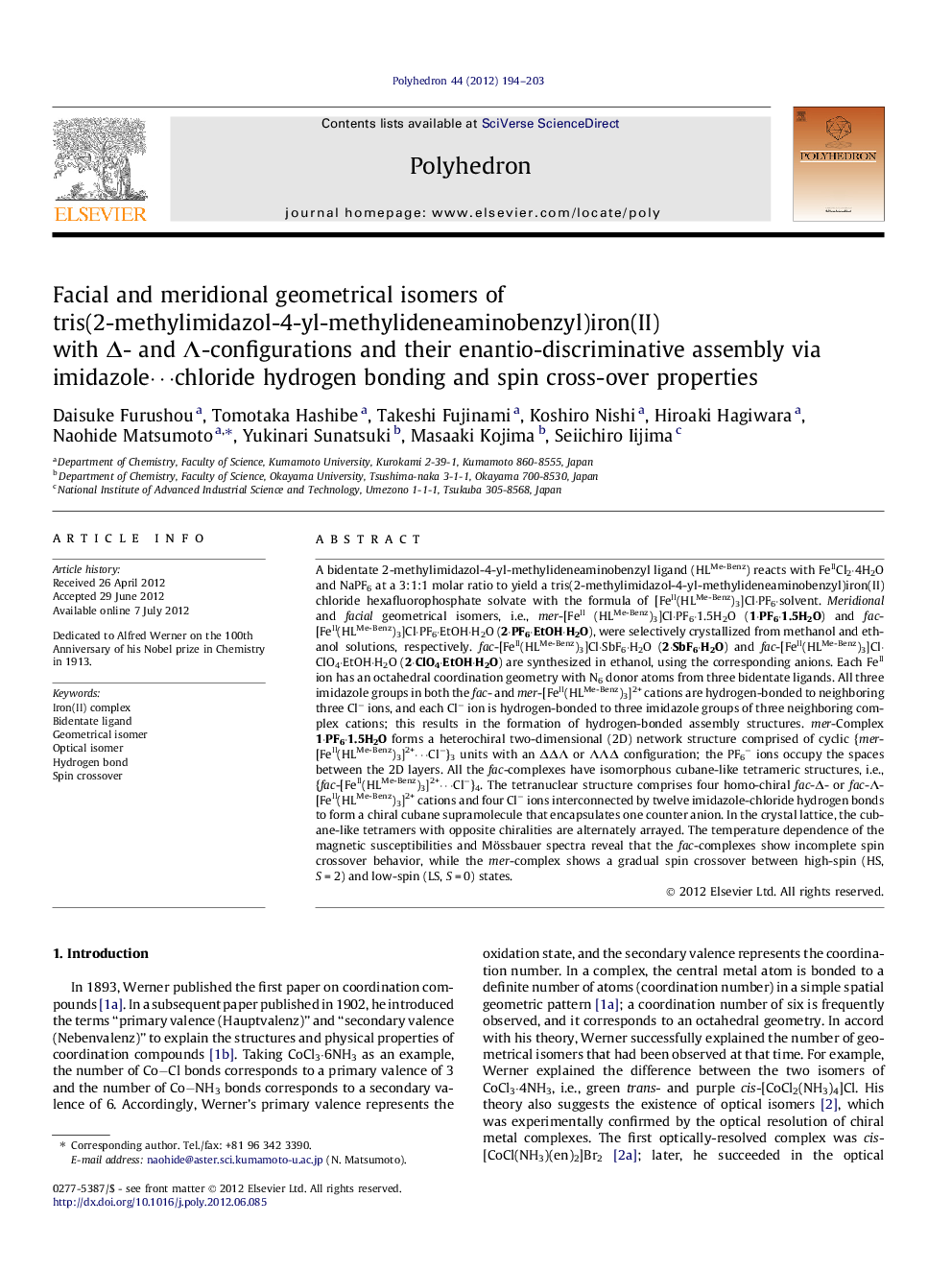| کد مقاله | کد نشریه | سال انتشار | مقاله انگلیسی | نسخه تمام متن |
|---|---|---|---|---|
| 1334742 | 979446 | 2012 | 10 صفحه PDF | دانلود رایگان |

A bidentate 2-methylimidazol-4-yl-methylideneaminobenzyl ligand (HLMe-Benz) reacts with FeIICl2·4H2O and NaPF6 at a 3:1:1 molar ratio to yield a tris(2-methylimidazol-4-yl-methylideneaminobenzyl)iron(II) chloride hexafluorophosphate solvate with the formula of [FeII(HLMe-Benz)3]Cl·PF6·solvent. Meridional and facial geometrical isomers, i.e., mer-[FeII (HLMe-Benz)3]Cl·PF6·1.5H2O (1·PF6·1.5H2O) and fac-[FeII(HLMe-Benz)3]Cl·PF6·EtOH·H2O (2·PF6·EtOH·H2O), were selectively crystallized from methanol and ethanol solutions, respectively. fac-[FeII(HLMe-Benz)3]Cl·SbF6·H2O (2·SbF6·H2O) and fac-[FeII(HLMe-Benz)3]Cl·ClO4·EtOH·H2O (2·ClO4·EtOH·H2O) are synthesized in ethanol, using the corresponding anions. Each FeII ion has an octahedral coordination geometry with N6 donor atoms from three bidentate ligands. All three imidazole groups in both the fac- and mer-[FeII(HLMe-Benz)3]2+ cations are hydrogen-bonded to neighboring three Cl− ions, and each Cl− ion is hydrogen-bonded to three imidazole groups of three neighboring complex cations; this results in the formation of hydrogen-bonded assembly structures. mer-Complex 1·PF6·1.5H2O forms a heterochiral two-dimensional (2D) network structure comprised of cyclic {mer-[FeII(HLMe-Benz)3]2+⋯Cl−}3 units with an ΔΔΛ or ΛΛΔ configuration; the PF6− ions occupy the spaces between the 2D layers. All the fac-complexes have isomorphous cubane-like tetrameric structures, i.e., {fac-[FeII(HLMe-Benz)3]2+⋯Cl−}4. The tetranuclear structure comprises four homo-chiral fac-Δ- or fac-Λ-[FeII(HLMe-Benz)3]2+ cations and four Cl− ions interconnected by twelve imidazole-chloride hydrogen bonds to form a chiral cubane supramolecule that encapsulates one counter anion. In the crystal lattice, the cubane-like tetramers with opposite chiralities are alternately arrayed. The temperature dependence of the magnetic susceptibilities and Mössbauer spectra reveal that the fac-complexes show incomplete spin crossover behavior, while the mer-complex shows a gradual spin crossover between high-spin (HS, S = 2) and low-spin (LS, S = 0) states.
The 3:1:1 reaction of 2-methylimidazol-4-yl-methylideneaminobenzyl (HLMe-Benz), FeIICl2·4H2O and NaPF6 gives meridional and facial geometrical isomers of mer-[FeII (HLMe-Benz)3]Cl·PF6·1.5H2O and fac-[FeII(HLMe-Benz)3]Cl·PF6·EtOH·H2O. All three imidazole groups are hydrogen-bonded to neighboring three Cl− ions; this results in the formation of hydrogen-bonded assembly structures. The mer-complex forms a hetero-chiral two-dimensional network structure, while the fac-complex forms a homochiral cubane-like structure. The magnetic susceptibilities data and Mössbauer spectra reveal that the fac-complex shows an incomplete spin crossover behavior, while mer-complex shows a gradual spin crossover.Figure optionsDownload as PowerPoint slideHighlights
► 2-Methylimidazol-4-yl-methylideneaminobenzyl is used as a bidentate chelate ligand.
► Iron(II) complexes with three bidentate ligands were prepared.
► Mer- and fac-isomers with Δ- and Λ-configurations are selectively crystallized.
► Three imidazole groups of a complex are hydrogen-bonded to three Cl− ions.
► 2D and cubane structures are constructed by the hydrogen bonds.
Journal: Polyhedron - Volume 44, Issue 1, 31 August 2012, Pages 194–203